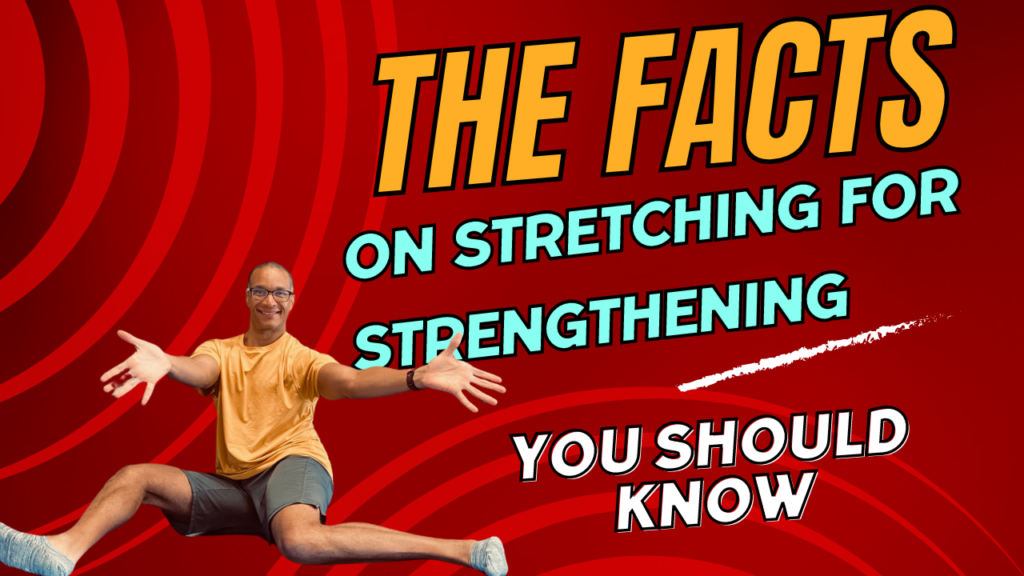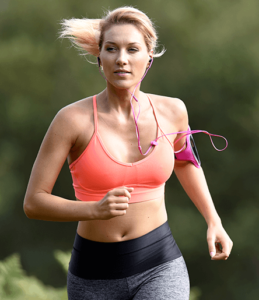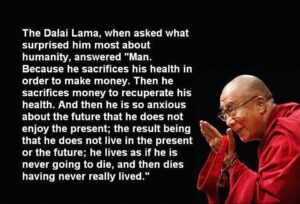Ever wonder how stretching could be the missing piece in your strength training puzzle? 🤔 Discover the incredible benefits of incorporating stretching into your fitness routine! Don’t miss out on these game-changing tips! Hit play and transform your fitness journey today! 🚀💥
Click on the image to watch the full video

Stretching is usually seen as a passive activity to kind of relax the muscles in the body and to kind of feel good. Maybe increase your range of motion, how flexible you are, and there’s an element that it does that. But stretching can also be active and stretching can help with the strength of your body. And so I take people through some of these stretches to help the strength of their body. They’re quite surprised. They’re surprised because they can’t believe how difficult it is relative to how tight they are. And then they can’t believe how much they translate into how much stronger they feel in their life. So how do they do that? Well, good thing you’re watching this video because we’re going to talk about that today. How’s it going? I’m Ekemba Sooh, I own SolCore Fitness. I’ve been in the health and fitness field for like 30 years.
So I’m a Soma Therapist and Soma trainer, which means I’m an osteopathic manual therapist and I’m osteopathic trainer, which obviously is underneath the osteopathic model. And osteopath says holistic and structured dictates function. But I didn’t start there. I started all the regular personal trainers before me by getting certified through whatever body certification that they do. They’re all basically the same, but they have stretching in there. But it’s the stretching that you’ve seen for decades now, the basic stretching. So I do it with my clients because it’s part of the curriculum and it helped a little bit, but it never was sustainable and that type of stretching didn’t lead to them being stronger. When I got into this osteopathy holistic world, I started to see how you can use this holistic model, namely the fascia and stretching to help increase your strength. So I like to talk about things in a holistic manner.
So that’s what I do on this channel. So if you want to hear that, then subscribe and hit that bell where about once a week, we’ll put out a new video. Then please share this video and then like it so that the YouTube algorithm, excuse me, will know that this is a good video and more people can see it. Stretching should not be an afterthought. It shouldn’t be something you do only when you feel tight or when it’s prescribed to you from a PT or somebody like me. It should be worked into your program. Really good stretching has the ability to keep your body balanced and functioning that way you can live the life that you choose. But like I said, the type of stretching you do is very important. The stretching you see from decades ago, like the BS do in the gym and stuff where they grab their foot and or throw the leg up on something or put their arm on to stretch like that, that’s crap. To be honest. There’s very little carry through that really helps your body in doing stuff like that. But if you can dial down the type of your stretching do and the times you do your stretching, your program and your life will explode. But before we dig in, let’s talk a little bit about some differences. Our stretching and warmup are two different things.
A warmup is something you do before an activity to prep your body for the activity, stretching something to help with normalization of the muscles you just use from that activity. A warmup will increase the potential that you already have at this moment. A stretch done right will increase that potential of what you ever want to do. So it’s for that reason that you should not do a stretch before you do anything active. And by active I mean anything outside just hanging out and walking or sitting down, whatever. So if you’re going on a hike, you’re going to go work out, you’re going to do some sort of sport activity. You don’t stretch beforehand. You do the warmup appropriate for that activity. They stretch afterwards. Now I know where that came from. They came from a study a long time ago where they measured stretching and range of motion and range of motions is acquitted to better functioning and all that is true.
But like all studies, it’s done in a little box just to measure that. It doesn’t measure anything else outside that in life. And so you can’t take something that’s measured in a box for this one little area and say it applies to everything. That study they did, they show that stretching increases your range of motion, but stretching increases your range of motion as a defense mechanism. So my elbow is only out able to extend here, but I wanted to get here. And so I put tension to get to that spot. It scares my body. And so I’ve got some prop preceptors, little computers in my body that say, ah, that’s about the tear. Shut that down so it can move further. Okay, shuts down. I now move a little further into the extension of the elbow. I’ve increased my range of motion, but the thing that happened was the body turned things off to get there.
So now I want to increase my range of motion and now I want to play tennis or throw a ball or something like that. Well, that area which is turned off, it’s turned off now when I go to throw the ball or hit with the tennis racket, now my body’s like, I don’t really know what to do now. It kind of just guesses how you want to do it. You won’t have the same type of form. Another point is that foam rolling is not stretching or warming up. I’m putting this in here because everybody lift a foam roll now, but foam rolling is very damaging to the fascia of your body and doesn’t allow for your fascia to function properly, which you’ll see later why that’s important. And so I wouldn’t use foam rolling or I wouldn’t use it for anything, but I would definitely not use it for a warmup.
So a little science before we start on why stretching helps improve strength. First, know that the way our body is built is called biotin. Tensity is from Buck Meister Fuller, and some really smart people saw that design say, Hey, that applies much to the body. It’s based on tension and compression. Everything has a job and should work together and should be no parts that are kind of on top and rubbing each other. The second is called heal muscle model and heal said that for muscle to work properly to be strong, there’s three components. There’s the muscle fibers, there’s a fascia that surrounds the muscle, and there’s a tendon that’s associated with that muscle. All three factors need to work as high as possible and together for your muscles to work properly. So we’re going to focus on that second component of his muscle model and the fascia that surrounds the muscle to talk about how it’s help increase increased strength.
So that fascia is all throughout the body. You can see if one fascia that connects your entire body. And so those fascial lines need to line up for me to have the best posture and balance. If I’m balanced, I have good strength. So I have good fascia right here. I’m balanced. If my fascia is all jumbled and my posture was like that, I won’t have as much strength because my weight is now asymmetrical. I wouldn’t be using a good balanced position to move from that. Fascia has a bunch of different jobs. I’ll list them here and they’ll pop up thing. But for the purpose of this video, we’re going to focus on structure, neurobiology and communication. So the structure is what I just talked about, your entire structure. Tension compression is based on those fascial layers. Those fascial layers go around those muscle fibers, but then they connect to the ligament.
The ligament connects it to periosteum, which is the bone periosteum to a tendon, tendon to another fascial layer, the entire body. So you want all those lined up so you’re nice and strong for neurobiology. The fascia surrounds your nerves, your epi, so you have that fascia that surround your nerves. If that fascia is not healthy and then nerves can’t do their job, then your muscles won’t get the proper conduction that they need to function properly. And then for communication where your fascia’s alive, it’s not. This is the white piece of stuff that you remove when you’re cutting your meat. It has a lot of jobs, like I said, and it needs to communicate with each other. If that faster can communicate to different chains and needs to communicate, then you move in a more coordinated fashion, which means now those exercises you do to get strong are more coordinated, easier to do, which means you can use more weight or more complexity wherever you need to do to gain strength.
Are you using stretching to increase your strengthening program? Are you using it via the mile fassal change? Let me know in the comments. So to stretch properly, so you increase your strength, you also need to take care of your fascia. So three things will affect your fascia, dehydration, stress, and not working with it, not working properly. So the first step is to, it’s very difficult to drink enough water. So you want at least a liter to two liters minimum of water in your body, depending on how big you are. But you want to work up to half your body weight and ounce of water. You want that to be plain water, which means nothing in it and not when you’re eating food. This plain water goes into your body and goes extra celery into soft tissue of your body and keeps it hydrated. It keeps it smooth, it keeps it liquid that your viscera, your internal organs and your muscles, tendons, ligaments, slide on water-based and not with friction.
Your stress is going to be up to you to have some sort of mental, emotional stress reduction time, whether it’s walking in nature, meditating, journaling, it’s up to you, but a little stress is fine. Too much is damaging not only for your fascia but for your life. The third part is you want to work with the fascia. Now you want to strengthen with the fascia mind. We’re not going to go into this too much because it’s about stretching, but when I strengthen, I can keep these myofascia chains in line through specific posture and then work the muscle fibers in all the different directions I go for stretching. You want to stretch these fascial layers in line. So again, we’re going with hill’s muscle model here. And also knowing that our body needs to be balanced. So fascia surrounds all the muscles and in three different layers, I want to take those layers and stretch ’em because fascia surrounds those muscles and it’s the bag of the muscle.
So if that bag of the muscle is all jumbled up in a bad shape, then your muscles are always going to be in a bad shape because the position of your fascia or how it is, will dictate the position of your muscles. So when I stretch your muscle, I’m going to stretch it mild fascially within a chain that it works because your muscles don’t work alone. They work with the rest of your body, but they work in different chains. So it’s called a gain. So gain means that my nervous system, nerves, spinal cords, joint, stuff like that, they communicate to different muscles in that chain to help coordinate them and work them well. So they all happen within this bag, in this chain of muscles. I hope you’re following. So if I stretch a muscle in that chain, then I’m increasing the flexibility of the bag as I talked about, so the muscles form in a better shape. I’m increasing that neuromuscular coordination within the gain of the specific muscle you’re
Working, but also the muscles that are associated with it, which is going to increase my strength. Now the hard part is knowing how to line these muscles up. There’s no easy answer for that one. That’s where you want to see somebody like myself. So you need to find somebody who’s well versed in the fascia of the body and how to strengthen it via these myofascial. But also on top of that, how to do segmental strengthening via the fascia. Work with the joints via the fascia, a bunch of different things with the fascia. So if you want help from me, that can help you out. The best thing to do is to reach out for a consult, right? So in the description below, there’ll be a link to where you can find your time and to talk with me, and we’ll go over what you want, what you need, what you’ve been doing, what you are doing currently, your sticking points, and then a way forward.
And I’m only going to offer my services to you. If I see you’re good fit. I’m always going to try and give you as much relevant information as you need for you. If you’re not ready for that, then that’s fine, right? So I’ve got another option for you. In description below, there’s a link for a free ebook. It’s four steps in how to get mobile, get out of pain, and Live your Best Life. It’s a nice book that talks about a lot of things I’m talking about here, but now you can digest it at your pace. So sign up for that and then just continue watching the video. So I’ll put a video here to watch next, but check out my channel. It’s all dedicated to holistic fitness, and so it’s going to help with your information. So don’t forget to subscribe. Hit that bell like and share. I’ll see you next week. Take care.

MOVE BETTER, REDUCE PAIN, AND LIVE LIFE ON YOUR TERMS
it’s not just working out, it’s building a foundation for a better life.
Find out more @



Leave a Reply